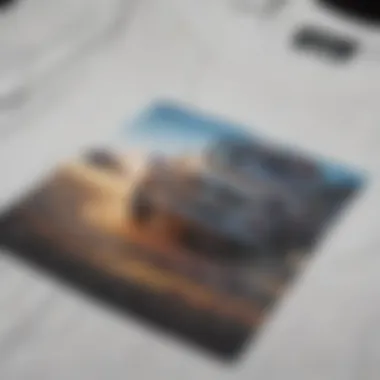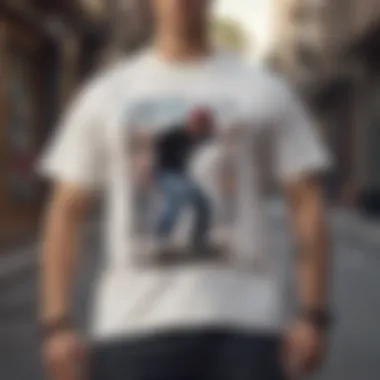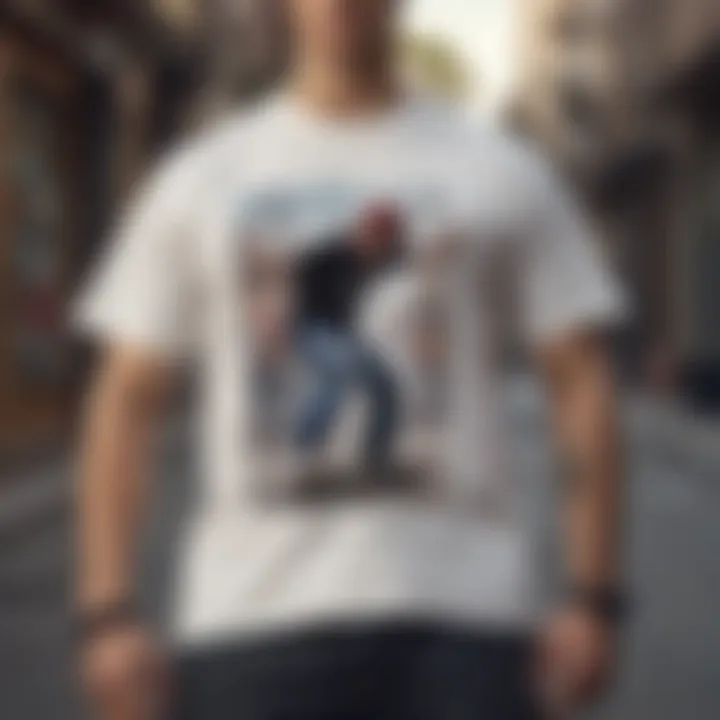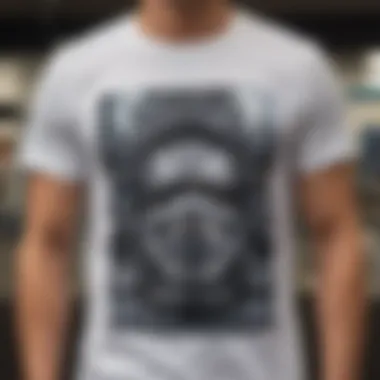The Evolution of Graphic T-Shirts for Men


Intro
Graphic T-shirts have carved out a unique space in the world of men's fashion. They aren't just basic clothing; these tees often reflect deeper cultural narratives, which broaden their appeal beyond mere aesthetics. Initially birthed as functional wear, graphic T-shirts have transformed dramatically, becoming symbols of identity, rebellion, and personal expression.
From vintage rock concert memorabilia to modern graphic designs that speak volumes, these garments have evolved continually, paralleling shifts in society and trends in art. This exploration aims to unpack that evolution, understanding how these shirts have become a canvas where individual artistry meets cultural commentary. Beyond just their visual appeal, graphic T-shirts resonate with diverse audiences—skaters, artists, and casual wearers alike—all of whom find meaning and connection through the designs they choose.
Techniques and Skills
In the world of graphic T-shirts, understanding the techniques and skills behind their creation can enhance both appreciation and production. Whether you're a beginning enthusiast or a seasoned designer, mastering these competencies can elevate your wear or your brand.
Essential Tricks for Beginners
Starting as a newbie doesn't mean you have to dive in headfirst without some guidance. Here are a few essential tricks:
- Choose Quality Fabric: Materials like cotton and blends enhance comfort and durability, making them ideal for printing.
- Consider the Fit: A well-fitting tee can transform a good graphic into a great one. Experiment with different styles—slim fit, loose, cropped—to see what works best for you.
- Leverage Online Resources: Websites such as reddit.com can connect you with communities that share tips and inspiration.
Advanced Techniques for Pros
For those already navigating the waters of graphic design, a few advanced techniques can really set your work apart:
- Experiment with Printing Methods: Techniques like screen printing, DTG (direct-to-garment) printing, or heat transfer can produce different effects. Each method has its advantages; knowing them can help you select the right process for your design.
- Incorporate Digital Art Tools: Utilize software like Adobe Illustrator or Procreate for refined designs. Familiarizing yourself with these can vastly improve your graphic creation process.
- Engage with Your Audience: Use platforms like facebook.com to showcase your work, get feedback, and adapt designs based on consumer interests.
Skateboarding Culture
Skateboarding culture has had a profound influence on the evolution of graphic T-shirts, turning them into a vital component of the skater's wardrobe. These shirts embody not just a style but an ethos—one of freedom, creativity, and individuality.
The Evolution of Skateboarding
Skateboarding has morphed significantly since its origins in the late 1940s. From its humble beginnings as an offshoot of surfing, it swiftly became a lifestyle filled with distinctive fashion elements. Vintage skate brands like Z-Boys set the tone, merging athletic wear with bold designs, which soon became symbolic of a youth-led cultural revolution. As skateboarding evolved, so did the graphic T-shirts worn by skaters, becoming bolder and more expressive.
Influential Skateboarders and Their Impact
Several skateboarders have not only impacted the sport but have helped shape the visual language surrounding T-shirts:
- Tony Hawk: Often heralded as the most famous skater, Hawk's influence extended to merchandizing and apparel, showcasing the skater image in mainstream culture.
- Rodney Mullen: Known as the godfather of street skating, Mullen's unique style influenced countless graphic designers to reflect the rebellion and creativity inherent in skate culture.
- Bam Margera: His persona brought a playful, edgy feel to skate fashion, pushing boundaries and inviting further experimentation in graphic expression.
"Graphic T-shirts are more than just fabric. They narrate stories, evoke memories, and foster connections among those who wear them."
The impact of these iconic skaters on graphic T-shirts cannot be understated, as their personal styles continue to inspire generations of designers and wearers alike.
As we delve further into the cultural significance and future of graphic T-shirts for men, it's crucial to consider the ways these designs reflect personal identity and societal shifts.
Prelims to Graphic T-Shirts
Graphic T-shirts have carved out a unique niche in men’s fashion. They serve as more than just garments; they are canvases for expression, identity, and even activism. Within the scope of this article, exploring graphic T-shirts isn't just about the clothing itself, but the tapestry of cultural meanings, artistic expressions, and trends woven through their evolution. Understanding this significance can empower wearers to embrace graphic T-shirts as powerful statements about who they are.
Defining the Graphic T-Shirt
Graphic T-shirts are a subcategory within the broader spectrum of casual wear. At their core, these shirts feature compelling images, illustrations, or texts that communicate ideas or sentiments, often reflective of the wearer’s interests or beliefs. They can range from minimalistic designs to highly elaborate artworks, covering topics such as music, art, humor, and social issues. While some may argue they are simply a fashion staple, for many, graphic T-shirts resonate on a deeper level, serving as a medium for personal storytelling.
The versatility of graphic T-shirts is evident in their popularity, appealing to various demographics, from skateboard enthusiasts to music lovers. The appeal lies in the ability to choose designs that resonate personally. Wearing a T-shirt that catches someone's eye can often spark conversations, creating an unspoken connection between individuals. Unlike traditional clothing, which might suppress individuality, graphic T-shirts allow people to wear their hearts on their sleeves, quite literally.
Historical Context
The journey of graphic T-shirts is deeply rooted in the evolution of casual fashion. While T-shirts originated as a basic undergarment in the late 19th century, it was during the mid-20th century that they began to emerge as a fashion staple. This shift ushers in a new era of self-expression, particularly among youth cultures.
In the 1960s and 70s, graphic T-shirts exploded in popularity, especially among groups looking to make bold statements. They became tools of protest during the civil rights movement and iconic imagery of rock bands, effectively merging art and fashion. For instance, the countercultural movements of these decades saw T-shirts adorned with revolutionary slogans, psychedelic designs, and famous band logos.
By the 80s and 90s, graphic T-shirts further evolved with the introduction of screen printing techniques, allowing for intricate designs that spoke to the punk, hip-hop, and skate cultures burgeoning at that time. The rise of independent brands marked a golden era for these garments, as they became vital to the identities of youth subcultures.
Fast forward to today, graphic T-shirts not only reflect personal tastes but continue to anchor socio-political movements and popular culture. With the rise of social media, these shirts can transmit ideas instantly, creating a massive intersection between fashion, identity, and activism, making it essential today to understand this modern evolution.
The Aesthetic Appeal of Graphic Designs


Graphic designs on T-shirts have transcended their status as mere clothing items; they've become a canvas of personal expression, cultural commentary, and art itself. Understanding the aesthetics behind these designs is crucial for anyone involved in fashion, whether they are skaters, hobbyists, or instructors. The visual elements chosen not only communicate identity but also connect with broader trends, societal movements, and the artistic landscape.
The aesthetic appeal of graphic designs plays a vital role in the popularity of graphic T-shirts for men. It enhances individuality and offers a way for wearers to showcase their interests, beliefs, and emotions through their attire. The intersection of art and personal expression forms a rich tapestry that reflects not just style but also backdrop influences from culture and society. As various styles take shape, they breathe life into the simplicity of a plain T-shirt, making the choice of graphic style paramount.
Types of Graphic Styles
Illustrative Graphics
Illustrative graphics stand out as a vivid canvas, often bursting with color and detail. Designed to catch the eye, they communicate complex themes and narratives. A key characteristic of illustrative graphics is their artistic nature; they usually feature drawings or images rather than standard logos or text. This quality makes them a popular choice for many young men looking to stand out in a crowd.
One unique facet is the versatility of illustrations. They can range from whimsical cartoons to intricate depictions of nature or urban life. The advantage here is that they allow for storytelling, inviting onlookers to pause and take in the nuances of the art. However, one potential disadvantage could be that busy designs might clash with the wearer's style, making them less versatile for everyday wear.
Typographic Designs
On the flip side, typographic designs utilize text as the main element, with phrases, quotes, or even one-word statements forming the basis of the design. The key characteristic here is clarity—these designs communicate messages directly, making them a powerful choice for self-expression. In many ways, they resonate deeply with those who wish to convey their attitude or philosophy succinctly.
The unique feature of typographic designs is their adaptability; a simple phrase can be rendered in various fonts, colors, and placements to create a distinct look. Moreover, they can provoke thought or evoke laughter, adding layers to the design. However, some may argue that they might lack creativity compared to illustrative designs, as they depend heavily on the potency of words rather than visuals.
Abstract Patterns
Abstract patterns represent a departure from literal imagery, favoring shapes, colors, and forms to create striking visual compositions. The defining aspect of these designs is their non-representational nature. Unlike illustrative designs that tell a story, abstract patterns invite personal interpretation, allowing wearers to connect with them on various levels. This becomes an appealing option for those who appreciate modern art aesthetics.
The advantage of abstract patterns is their inherent versatility; they can suit various personal styles while remaining relevant in fashion trends. Furthermore, they can captivate through simplicity or complexity, depending on the design elements chosen. A disadvantage, though, might arise from their ambiguous nature; some people may find it difficult to relate to abstract art, potentially diminishing their popularity among specific demographics.
Color Theory in Graphic T-Shirts
Color plays a critical role in graphics as it can significantly influence mood and perception. Understanding the theory behind colors is essential for creating and selecting appealing graphic T-shirts. Each hue resonates differently, impacting how wearers feel and how others perceive them. For instance, bold colors like red can imply energy, while softer shades like pastels can evoke calmness.
Selecting the right colors enhances not just the aesthetic appeal of a graphic T-shirt but also its emotional impact on the wearer and observers.
Additionally, combinations of colors can either harmonize or create contrasts, intensifying the visual message of the design. Therefore, choosing a color scheme that complements the overall graphic theme is vital in curating a shirt that aligns well with the wearer’s personality and fashion sense.
Printing Techniques for Graphic T-Shirts
Understanding the printing techniques for graphic T-shirts is crucial, especially for skaters, hobbyists, and instructors who want their designs to stand out. The right technique can greatly affect the durability, vibrancy, and overall aesthetic of the print. As such, exploring these methods offers valuable insight into how graphic shirts are developed for both personal and commercial use.
Screen Printing vs. Direct-to-Garment
Screen printing has long been a favorite in the world of graphic T-shirts. This method involves pushing ink through a mesh screen, creating a stencil that applies the design directly onto the fabric. One of the biggest advantages of screen printing is its ability to produce vibrant colors and sharp lines. This makes it an excellent choice for designs that require strong color contrasts or intricate details.
However, screen printing is not without its drawbacks. It can be relatively costly for smaller runs and requires significant setup time, which can be a hassle for one-off designs or small batches.
On the other hand, Direct-to-Garment (DTG) printing has emerged as a solution for those looking for quick turnaround times and minimal setup costs. In this technique, an inkjet printer applies designs directly onto the fabric. DTG makes it possible to print complex images or photorealistic designs with a wide range of colors without the limitations of screen printing.
That said, DTG printing may not hold up as well as screen printing. It can fade more quickly with multiple washes, especially if the fabric isn't high-quality. Thus, the choice between screen printing and Direct-to-Garment depends on the specific needs of the project.
"Choosing the right printing technique is like picking the right tool for a job. It can make all the difference in the outcome."
Heat Transfer Methods
Heat transfer methods have gained traction as well, offering a different avenue for crafting graphic T-shirts. The process typically involves printing the design onto a special transfer paper, which is then applied to the garment using heat and pressure. This technique allows for a great deal of flexibility in design and a quick turnaround, which is particularly appealing for small businesses or custom projects.
One prominent type of heat transfer is vinyl cutting. In this method, the design is cut from a roll of vinyl, and then it is heat-pressed onto the shirt. This provides a clean, sharp finish that's durable and often used for simple designs. It’s perfect for individual names or numbers on sports shirts.
While heat transfer methods offer convenience, they do have some limitations. The designs may not be as long-lasting as those created through screen printing, especially when subjected to frequent washing. Also, fine details may sometimes get lost in translation, especially with larger prints.
Ultimately, selecting a printing technique boils down to the desired outcome and practicality. Each method has quirks and merits that can suit different artistic visions or needs.
By delving into these printing techniques, one gains a clearer perspective on how innovations and traditions converge, shaping the graphic T-shirt landscape. The right choice can elevate a simple garment into a canvas of expression, relevant to the wearer's identity and passions.
Materials Used in Graphic T-Shirts
When discussing graphic T-shirts, it’s essential to dig into the materials that form the backbone of these captivating items. The choice of fabric not only impacts the final look but also dictates the feel, longevity, and overall experience of wearing the T-shirt. As consumers, making informed decisions about the materials is crucial, especially for skaters, hobbyists, and instructors who often engage in active lifestyles where comfort and durability are paramount.


Cotton: The Go-To Fabric
Cotton has long claimed its place as the favored fabric for T-shirts, and for good reason. This natural fiber brings a multitude of benefits that are hard to overlook.
- Breathability: Cotton allows air to circulate, reducing perspiration—important for those hot summer skate sessions.
- Comfort: The softness of cotton against the skin can’t be denied, providing comfort that lasts throughout the day.
- Ease of care: Cotton T-shirts are generally machine washable and durable, making them a practical choice for everyday wear.
- Versatile designs: Whether it’s an intricate graphic or bold typography, cotton handles screen printing and other techniques beautifully, ensuring that designs remain vibrant over time.
For many skaters, a well-fitted cotton graphic T-shirt can become a staple in their wardrobe, providing not just style but also a canvas to express personal identity and interests.
Polyester and Blends
While cotton rules the roost, polyester and its blends have carved out a significant niche in the graphic T-shirt market. This synthetic fiber offers distinct advantages, especially suited for those who live an active lifestyle.
- Moisture-wicking properties: Polyester tackles sweat with aplomb, drawing moisture away from the body. For skaters, this is a game-changer—allowing them to stay dry even during rigorous stunts.
- Durability: T-shirts made from polyester tend to hold up better against wear and tear. They are less prone to shrinking and stretching, making them ideal for repeated use.
- Color retention: The dyeing process for polyester tends to result in brighter, more UV-resistant colors, ensuring that graphic designs look sharp and lively longer.
- Blends for the win: Many brands offer cotton-polyester blends, marrying the comfort of cotton with the durability of polyester. This combination can provide an exceptional balance between style and performance.
"The right material can elevate a graphic T-shirt from a mere piece of clothing to an extension of personal style and expression."
Selecting the right material not only affects the T-shirt's performance but also influences how it aligns with one's ethos and way of life. As trends evolve, understanding these materials and their implications can help individuals make choices that reflect their values and needs.
Cultural Impact of Graphic T-Shirts in Skateboarding
Graphic T-shirts have stood the test of time as a significant facet of skateboard culture. They serve as a window into the artistic and personal identities of skaters, capturing what they stand for and celebrate. From the rebellious spirit of the sport to the community's creativity, graphic T-shirts embody more than just clothing. They hold cultural resonance and reflect evolving trends, making them quintessential in understanding skateboard culture.
The Intersection of Art and Sport
Within the skateboarding community, graphic T-shirts act as a canvas for artistic expression. It's not just about the action on the board but the culture surrounding it. Many artists and designers from the skate world contribute their unique styles to T-shirts, effectively intertwining art with the physicality of the sport.
- Creative Expression: Skaters often use graphic design to communicate ideals such as freedom, rebellion, and individuality. Variants from iconic logos to edgy illustrations attract attention and invite conversations. More than just a design, each shirt tells a story.
- Collaboration with Artists: Many skate companies engage with local artists to create exclusive pieces, fostering a sense of community. This not only supports the art scene but also encourages diversity in style, making each shirt a piece of history.
- Cultural Significance: The designs often highlight significant cultural moments, reflecting socio-political issues or the evolution of skateboarding itself. For instance, many designs capture the spirit of protests or major skate events, fostering a sense of unity among skaters.
Iconography in Skate Style
The use of symbols and icons in graphic T-shirts goes beyond aesthetics; they act as markers of group identity within the skateboard scene. These elements often draw on various influences, from punk rock to street art.
- Symbols of Rebellion: Many designs utilize imagery that symbolizes defiance against societal norms, linking skate culture to punk roots. Wearing such shirts is an outright expression of one's belief in challenging authority.
- Brand Logos: Iconic skateboard companies like Supreme and Baker often emblazon their logos on T-shirts. These brands have established a strong identity within the community where wearing them can signify one's allegiance to a specific skate culture.
- Subcultures within Skateboarding: Different styles of skateboarding—like street, vert, or even bowl skating—can influence the graphics seen on T-shirts. Certain subcultures tend to prefer specific designs that reflect their unique lifestyle and approach to the sport.
Graphic T-shirts in skateboarding are not merely fashion items; they encapsulate the essence of a culture that thrives on community, artistry, and self-expression. While skateboarding continues to evolve, these T-shirts will likely remain a cornerstone of its identity, serving both as an expression of artistry and a sense of belonging.
Influence of Pop Culture
The impact of pop culture on graphic T-shirts cannot be overstated. This vibrant intersection of art, style, and mainstream media shapes not only what people wear but also how they express themselves. From music to film, the graphics plastered on T-shirts serve as a canvas, showcasing cultural references that resonate deeply with both designers and wearers. Pop culture acts as a conduit through which individual personalities shine, allowing for personal narratives to unfold right on one's chest.
Music and Graphic T-Shirts
Music has long been a cornerstone of graphic T-shirt designs, establishing a bridge between fans and their favorite artists. Think back to the iconic band tee: a simple black shirt emblazoned with a logo or album cover that speaks volumes about one’s musical tastes. Artists like The Rolling Stones, Nirvana, and Queen have contributed timeless graphics that define generations. These T-shirts do more than just exhibit a logo; they encapsulate a lifestyle and an allegiance to a particular music genre.
Unsurprisingly, the rise of various music festivals has amplified the graphic T-shirt phenomenon. Festivals such as Coachella and Glastonbury see thousands of fans sporting their favorite artists’ merch, showcasing designs that feature not only band names but also art that connects with the festival's ethos. Additionally, collaborations between pizza and punk classics, like the Anti-Flag pizza design, illustrate how graphic representation reflects broader cultural themes.
"Graphic T-shirts become a social language—an unspoken agreement of identity shared among fans."
Moreover, music subcultures often dictate the aesthetic of graphic T-shirts, from the vibrant tie-dye prints of the '60s hippies to the stark, grunge-infused styles of the '90s. This direct relationship with music has fostered a kind of storytelling through textiles, where each shirt operates as a badge of belonging.
Film and Television
Film and television have equally played a significant role in shaping graphic T-shirt designs. Iconic movie images and quotable lines have inspired a myriad of designs that resonate with audiences. Take, for example, the T-shirt featuring Jack Nicholson's chilling grin from The Shining. It tells as much about one’s filmic preferences as it does about personal bravado in fashion choices. Designs based on franchises like Star Wars, Stranger Things, and superhero comics have become staples in wardrobes worldwide.
Television series, particularly those with rich character and storyline development, have birthed their own lines of graphic T-shirts. Friends T-shirts featuring the Central Perk logo evoke nostalgia, while Game of Thrones-inspired designs capture the complex world of Westeros with intricate artwork and meaningful iconography. Just as with music, these shirts allow viewers to showcase allegiance to a particular narrative universe.
In essence, graphic T-shirts serve as a bridge between media and personal identity. They encapsulate passions and shared cultural experiences, allowing enthusiasts to connect over common interests while strutting their style. This blend of art and commerce reflects more than just trends; it represents a canvas for thoughts, emotions, and a shared cultural lexicon.
Consumer Trends and Market Analysis
Understanding the landscape of consumer trends and market analysis is vital when examining the graphic T-shirt movement. It informs us about not just what people are wearing, but why they choose certain designs and styles over others. As this genre of clothing has evolved, so has the mindset of those who wear them. The growing emphasis on individuality and personal expression drives this segment of fashion. Furthermore, recognizing shifting preferences among consumers can unveil patterns that shape the designs we see on shelves.
With the rise of social media and online platforms, the popularity of graphic T-shirts has rocketed. It’s almost like the fashion choices of influencers have morphed into a digital trendsetter model, leading to rapid shifts in what’s in vogue. Brands have to be especially nimble today; they need to adapt quickly to emerging styles and cultural movements, all while ensuring sustainability and ethical practices are at the heart of production.


Demographic Insights
To dive deeper, we need to explore the demographics behind the consumer base of graphic T-shirts. Traditionally, young men have been at the core demographic, attracted by vibrant graphics and edgy designs. However, this age group isn't the only consumer driving trends. There’s a noticeable convergence happening where older men and women are also getting in on this trend, sporting graphic tees that represent their interests or favorite pop culture phenomena.
- Age Groups:
- Teenagers and young adults (ages 16-30) prioritize bold statements and pop culture references.
- Middle-age consumers (ages 31-50) often seek nostalgia-driven designs or subtly artistic prints.
As consumers mature, their designs often evolve too; they may begin with quirky pop culture graphics and, over time, look towards more refined styles that may emphasize artistry or even understated designs.
Sustainability in Production
Sustainability is no longer just a passing trend—it’s become a core expectation among conscious consumers. In the context of graphic T-shirts, buyers are increasingly considering where and how their garments are produced. They want to spend their hard-earned cash on brands that align with their values.
- Eco-friendly Materials: Consumers are gravitating towards T-shirts made from organic cotton or recycled materials, which speaks to a broader desire for sustainable fashion.
- Ethical Practices: Shoppers are demanding transparency from brands. Knowing about fair labor practices is just as crucial as understanding product quality.
Designing Your Own Graphic T-Shirts
Creating your own graphic T-shirts can be a transformative experience. This section examines the significance of this practice in the context of self-expression, creativity, and identity. For many, designing graphic tees is not just about fashion; it is a medium through which individuality and personal narratives can be communicated. Whether one is a seasoned artist or a novice enthusiast, the ability to craft a unique design offers not just a creative outlet but also a chance to engage with various communities and cultures.
Concept Development
When it comes to crafting your own graphic T-shirts, the initial stage of concept development is vital. This phase involves brainstorming ideas and sketching out themes that resonate with your vision. Think about what message you want to convey—are you aiming for humor, nostalgia, or perhaps a statement about social issues? Here are some elements to consider:
- Target Audience: Understand who will wear your T-shirt. Are they skaters, music lovers, or art enthusiasts? Knowing your audience shapes your design choices.
- Visual Inspiration: Draw inspiration from various sources—art, nature, or even urban landscapes. Platforms like Pinterest can be a goldmine for visual ideas.
- Drafting Designs: Sketch multiple variations before committing to one. Even if you're not an artist, simple doodles can clarify your concepts. Use digital tools like Adobe Illustrator or free software like Canva to create more polished drafts.
- Feedback Loop: Share your concepts with friends or online forums. Their insights can refine your design or even spark new ideas. Reddit is a great space to receive constructive feedback.
Finding the Right Printer
Once you have a design that catches your fancy, the next crucial step is finding a reliable printer. The right printer can make or break your T-shirt vision. Here are a few steps to ensure you choose wisely:
- Research Printing Options: Look for companies that specialize in the method you choose, whether screen printing, direct-to-garment, or heat transfer. Each has its own set of advantages. For instance, screen printing can be cost-effective for large orders, while direct-to-garment printing works well for intricate designs.
- Quality of Work: Always request samples. Examine the texture of the fabric and how well the print adheres to it. Look for reviews and testimonials to gauge the experience of previous customers.
- Customer Service: A good printer should be communicative and responsive. They can assist you with any queries and guide you through the printing process. Don't hesitate to reach out to multiple printers before making a final decision.
- Cost Considerations: Compare pricing among different printers, but balance cost with quality. A lower price might lead to lower-quality prints, ultimately affecting the design's lifespan.
"The creative process is more than just putting paint on a canvas; it involves communication, connection, and, above all, clarity in executing your vision."
This comprehensive exploration of designing graphic T-shirts reveals how personal expression can manifest in fashion. Engaging deeply in both the concept and production processes enriches not just the garment but also the designer's journey.
The Future of Graphic T-Shirts
As graphic T-shirts continue to carve their niche in the ever-changing landscape of fashion, exploring the future of these garments reveals not only their lasting relevance but also the potential for innovation. The evolution of graphic t-shirts is marked by an intricate dance between cultural shifts and technological advancements. This section aims to tap into the pulse of what lies ahead for graphic T-shirts, unraveling emerging trends and technological leaps that promise to reshape how these fashion staples are designed, produced, and worn.
Emerging Trends in Fashion
The realm of graphic T-shirts is not static; it morphs and evolves in response to broader fashion currents and societal preferences. Here are some visible trends on the horizon:
- Sustainable Production: More brands are moving towards eco-friendly practices. Using organic cotton, responsible sourcing, and recycling has gained traction. This shift aligns with the growing consumer demand for environmentally conscious products. Scenarios in which a skater wears a shirt made from recycled plastic waste could become a norm, showcasing their commitment to the planet.
- Personalization: There’s rising popularity in tailored designs. Consumers are seeking T-shirts that tell their unique stories or represent personal ideologies. Expect platforms that allow users to customize graphics or a blend of designs to flourish as this becomes a central part of self-expression.
- Graphic Narratives: Storytelling through graphics is an emerging trend. Designs infused with symbols or motifs telling stories might resonate stronger with a generation that increasingly craves authenticity. This could reflect in collaborations with artists or features inspired by local cultures, emphasizing connection.
- Diverse Representation: The shifting societal narratives push for broader representation within fashion. Expect graphic t-shirts highlighting diverse cultures, identities and stories. This could lead to a melting pot of styles that resonate deeply with varied audiences, making the graphic Tee a cultural conversation starter.
Technological Advancements
The intersection of technology and design is a thrilling arena to keep an eye on. Here are several advancements that pave the way for the future of graphic t-shirts:
- Smart Fabric Technology: Imagine T-shirts that not only look good but can also interact with the wearer’s environment. Smart fabrics that change design based on temperature or time of day could make waves in fashion. Such concepts suggest advanced interactive graphics that cater to the wearer's mood or context—like a shirt that displays different designs based on your fitness level.
- Augmented Reality Integration: Incorporating AR in graphic t-shirts might sound like science fiction, but it’s inching closer to reality. Imagine wearing a shirt, scanning it with a phone, and watching a dynamic animation come to life. This could enhance the storytelling aspect of T-shirts, embedding deeper layers of connection and experience.
- 3D Printing on Demand: The ability to produce graphic t-shirts using 3D printing offers unlimited design possibilities with minimal waste. This method enables rapid prototyping and customization, catering to the market's ever-diversifying tastes. With this technological marvel, one can print a T-shirt with intricate designs right at home, eliminating the traditional production methods.
"The future of graphic T-shirts is not merely a continuation of the past, but a reimagining of how these garments can function as personal, cultural, and expressive mediums."
Closure
In wrapping up our exploration of graphic T-shirts for men, it becomes clear that this garment has transcended its origins as simple attire. Graphic T-shirts have evolved into a complex medium for self-expression, identity, and cultural commentary. Whether it’s a nod to a favorite band, a statement about social issues, or a showcase of artistic talent, each shirt tells a story.
As discussed in earlier sections, understanding the different styles, printing techniques, and materials not only aids in appreciating the evolution of these shirts but also enables consumers to make informed choices when purchasing. The diversity of graphic designs available today caters to myriad tastes, ranging from striking illustrations to subtle typographic designs.
Key Takeaways:
- Graphic T-shirts serve as a canvas for artistic expression, embodying personal and cultural narratives.
- The interplay between materials and printing techniques influences the overall quality and aesthetic of the shirts.
- Consumer awareness around sustainability is shaping production choices, pushing brands to innovate responsibly.
"Fashion is the armor to survive the reality of everyday life." – Bill Cunningham
This quote encapsulates the relevance of graphic T-shirts in men's fashion. They aren’t just clothing; they are a reflection of who we are and what we believe. As we look to the future, it’s likely that graphic T-shirts will continue to evolve, driven by technological advancements and shifting cultural landscapes. For skaters and enthusiasts alike, these shirts remain a vital piece of the wardrobe, connecting personal identity with broader cultural movements. Whether worn at skate parks or casual hangouts, these shirts signify not just style but also a shared sense of belonging in a larger community.
Ultimately, recognizing the significance of graphic T-shirts expands our understanding of fashion as a dynamic interplay between art and identity. It is a testament to how a simple piece of clothing can embody so much more than just fabric—it can encapsulate emotions, beliefs, and even movements within society.







